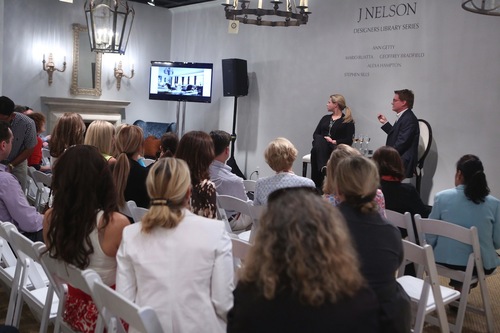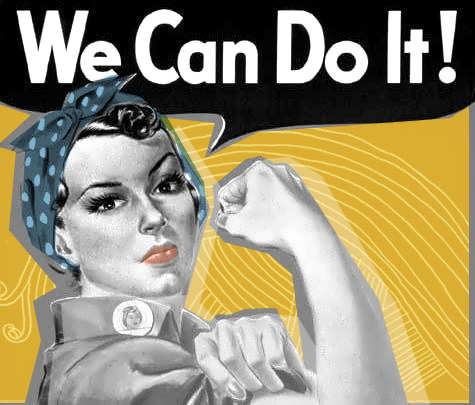For six weeks, I just traveled all over Central and South America with my girlfriends. Then I came back and joined this place called TechShop in San Francisco, which is like a gym for making things. I realized I was fairly burnt out with the Internet and technology, and really wanted to return to that part of my childhood where I loved to just make and create. They had all these modern machines, like 3-D printers and laser cutters, as well as a lot of traditional machines, like screen printers and letterpress machines and sewing machines. I started going at least once a week.
It was a wonderful immersive and creative experience, and really opened my mind to how the world of creativity was changing as technology was improving. As I was at TechShop, I noticed that a lot of the people around me were men. At this same time, Pinterest had just launched, and that community was largely all women and the thing they were pinning the most were DIY projects and creative types of ideas. I realized this generation of women has no idea how to cook or sew or decorate or do any of these domestic things. There was no resource to help them learn and create as a community.
So much of what I wanted Brit + Co to be about is learning and teaching and feeling accessible. I didn’t want women to feel like they couldn’t do it because they weren’t good enough. We all have things that we gravitate toward. It’s hard to be really great at all things. I knew that with this generation also being the social media generation, the best way to connect with this audience was to be the real me, as a woman who has grown up the same way they did.
My first step was to just start making things. I think a lot of people when they’re starting businesses get hung up on making it perfect as opposed to just putting the idea out there and seeing if it’s sticky. I launched the company by myself from my apartment. I incorporated as a business and started building the site. I hired a freelance designer to help me put the website together, but I also wrote code.
I had to seed the website with a lot of content, and it was mostly projects and tutorials as well as easy ideas for being more creative in your home — whether that’s an idea for cooking, decorating, crafting, or getting ready for the day. I launched the site in November 2011, and just started putting it out there and building a social media following on Twitter, Facebook, and Pinterest. I’d post my content to these networks and very rapidly started building up followers across all the platforms. I knew it was resonating and that I needed more content. So I hired a creative director, who is our resident maker. She started coming to my apartment in San Francisco, and we would just make anything that inspired us. We would photograph the best we could, write about how we did it, and post it, hoping they would catch fire and inspire others to give it a try. My next hires were two engineers. I was paying everyone out-of-pocket for about four months. By the time we hit 100,000 to 200,000 monthly users, I started going to investors.
We just went for it like anyone launching a company in Silicon Valley. We made the pitch deck about the business, identified the huge gap we saw in the market, how Brit + Co could fill it, how we envisioned ourselves making money, who our team was, and who we wanted to bring on. I started with mentors and my network, and expanded outreach from there. Ultimately we found a few investors that believed in our business and wanted to support us. We raised a $1.25 million seed round in April 2012.
We then moved out of my apartment into office space in San Francisco. I grew the team to about 10 people that year, and a year later, we had about 600,00 to 700,000 monthly unique users.
To monetize, we ran ads very early on and mostly worked with advertisers on a reactive basis — they came to us; we didn’t go pitch them. Advertising is pretty straightforward as a business. We have a large, engaged audience, and they want to get their brand in front of that audience. So, we just started thinking about how to pair those two things together.
The first year, we probably had 10 to 20 advertisers. Once we brought on a real sales team, that number shot up significantly. We’ve worked with over 100 brands at this point, and most of them are returning to advertise with us. We also now have two additional revenue streams: e-learning and e-commerce. People can take classes on our site to learn new skills, and we supply them with DIY kits and tools. And they can also buy products they see featured on the site. Makers can also sell back their merchandise in our marketplace. It’s sort of like Etsy, but it’s curated by our editors.
As the business grew, we raised another $6.3 million in Series A financing. Seed funding is typically the first round of funding that helps companies get off the ground. It’s enough to keep the lights on as they get their vision together and experiment a bit. Series A is the round after the seed round, generally bigger, and allows companies to really start hiring substantial teams and building out product streams. You definitely need to have proven your market, growth, and engagement at this stage.
The hardest part sometimes is having a creative mindset. I know how big this business can be, and I have a never-ending stream of ideas for all the things I want to do. But to build a successful business, you have to focus and take it one day and one step at a time. It can be hard to prioritize.
We’re now close to 50 employees. We have millions of dollars in revenue a year. And we reach about 10 million women every month.
Every day is totally different. I usually wake up at 6 a.m. and have an hour of my own time before my son [born in October 2014] wakes up. I spend an hour or so with him, getting ready for the day, then I am in the office around 9 a.m. I have a strict policy about only allowing meetings on my calendar from 1 p.m. to 5 p.m. That leaves me with a few hours in the morning to get email and other large projects done. My meetings are totally different depending on the day. One day it’s meeting with our partners at Hallmark to talk about a big campaign, then interviewing and recruiting a designer or engineer, then doing a one-on-one with an executive on my team. Throughout the week, I have internal meetings with every team to work on product and engineering plans, design reviews, marketing campaigns, etc.
I’m genuinely passionate about this business. I was one of those women who was insecure about my own creativity, and I want to help other women and girls believe in themselves. I’m inspired daily by our makers and their varied passions and talents. I’m constantly trying projects that our community comes up with. My latest obsessions have been clay and pottery and calligraphy. I even took one of our own e-classes to learn how to do calligraphy.
I can do this for the rest of my life. I have years’ worth of ideas.
Correction: A previous version of this article stated that Brit + Co. raised its seed round in April 2011. It was 2012. This has been corrected.
Get That Life is a weekly series that reveals how successful, talented, creative women got to where they are now. Check back each Monday for the latest interview.
Follow Heather on Twitter.
Source:


